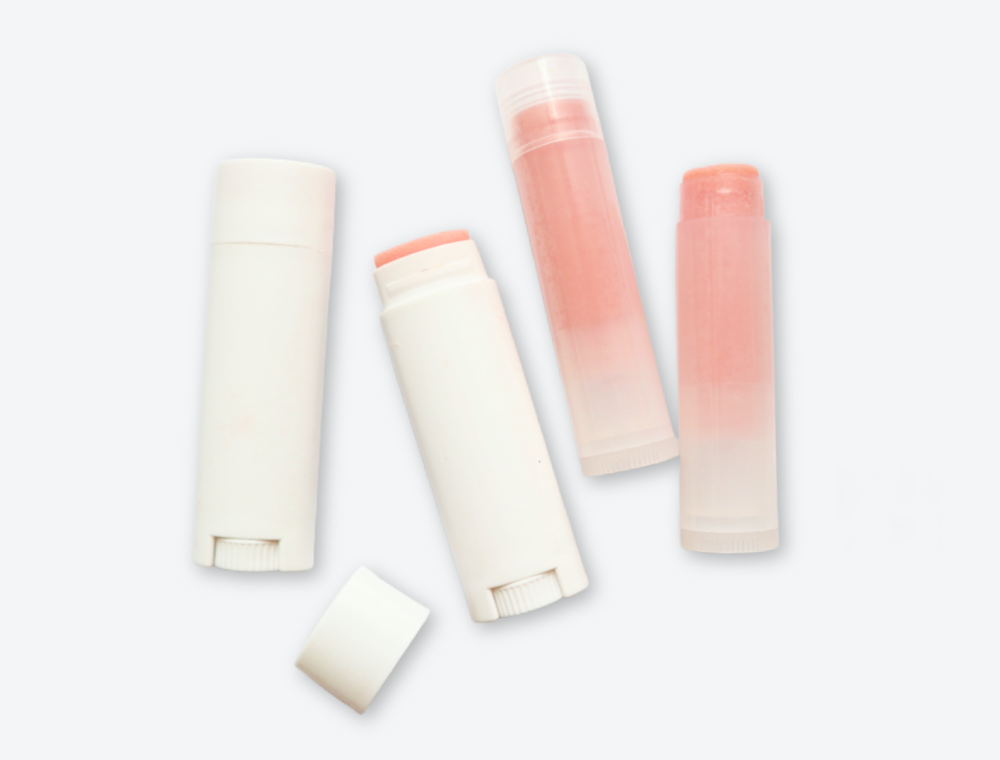DIY lip balm is one of the easiest projects you can make at home! If you’ve already made our recipe for tinted lip balm, you might be wondering how to make a flavored lip balm recipe. Flavored lip balm is super easy to make, and with our 10 new flavor oils, you have lots of fun options to choose from!
Below, learn more about lip balm flavor oils and follow our super easy flavored lip balm recipe at the end of this blog.
What is lip balm flavor oil?
A lip balm flavor oil is simply a scented oil that gives a product its taste. Lip balm flavor oils are actually food-grade fragrance oils. As such, you may also hear lip balm flavors referred to as flavor fragrance oils.
As a food-grade product, flavor fragrance oils are regulated by the FDA. Lip balm flavor oils are made with ingredients that are Generally Regarded As Safe (GRAS) by the FDA.
Although flavor oils are made with GRAS ingredients, they are not meant to be consumed in large quantities. You only need a tiny amount of flavor oil to give your products a taste.
With that being said, unsweetened flavor oils do not actually have a taste on their own. In order to taste flavor oils, you need to add a sweetener to your recipe. Once sweetener is added, it allows you to taste the flavor.
We also carry a variety of pre-sweetened lip balm flavorings. These flavor oils can be added to any lip balm recipe without needing another sweetener.
Note that fragrance flavor oils are not the same as the food flavor oils that are produced by the food industry. Food industry flavor oils are not usually formulated to work with oil-based applications such as lip balm. We don’t recommend using food flavor oils in lip balm recipes.
How much flavor oil can I use in lip balm?
Because they are technically fragrances, flavor oils are also regulated by the International Fragrance Association (IFRA). The IFRA determines the maximum skin exposure levels for each fragrance. Even though flavor oils are made with GRAS ingredients, you still need to refer to the IFRA statement for each flavor oil to determine the amount you can safely use for different applications.
For lip balm and other products worn on the lips, the maximum skin-safe level for flavor oils can range from 2% to 100% of the total weight of your product. The specific amount will vary depending on the flavor oil you use.
Keep in mind that like fragrance oils, you do not need to use the maximum amount of flavor oil allowed on the IFRA statement. If a high percentage is listed on the IFRA statement, it simply means you could safely use up to that amount, not that you should use that amount. For example, if using a flavor oil that can safely be used at 75% of the weight of your product, you would never want to use the full 75% in your lip balm recipe.
So how much flavor oil should you use? For most recipes, anywhere from 0.5% to 5% flavor oil is plenty. Remember to never exceed the maximum skin-safe level allowed by the IFRA statement.

How are flavor oils different from fragrance oils?
Because flavor oils are technically fragrance oils, you might be wondering what sets them apart. As mentioned above, one difference is that flavor oils are made with GRAS ingredients, whereas fragrance oils are generally not made with GRAS ingredients.
The other main difference is that fragrance oils for candles are made with solvents that help deliver the scent better. The solvents used for candle fragrance oils are not safe for consumption. However, these ingredients are responsible giving candle fragrances their strong scent throw.
Because lip balm flavor oils are not made with the same types of ingredients as candle fragrances, they do not generally have a very strong scent throw. For that reason, lip balm oils are not suited for scented products like candles, wax melts, aroma beads and other similar items. And while lip balm flavorings are skin-safe, they also are also not formulated to have a strong scent throw in soap, bath bombs, lotion or other bath and body products.
You can use unsweetened lip balm flavorings to make bath and body products, but for best results, we recommend using skin-safe fragrance oils instead. We only recommend using our flavor oils to make lip balm and other products used on the lips.
Note: Some people like to use unsweetened lip balm flavor oils for pet products, as these may be licked off. If using flavor oils to scent your pet products, refer to the IFRA statement for maximum skin-safe levels.
How to Use Lip Balm Flavor Oils
Now that you have a better understanding of what flavor oils are, you can start using them in your projects! When using unsweetened flavor oils in your recipe, remember that you will need to add a sweetener in order to taste the flavor. On the other hand, our sweetened flavor oils can be added directly to your lip balm recipe without additional sweetener.
How to Sweeten Flavor Oils
For our unsweetened lip balm flavor oils, we recommend using liquid stevia. We have found that liquid stevia performs the best out of all the sweeteners we have tried. We like sweetening lip balm with liquid stevia because it does not produce a gritty texture. Liquid stevia can be found at most grocery stores, or ordered online.
Powdered stevia, granulated sugar, honey and other sweeteners can be used to sweeten lip balm recipes, but these options tend to produce an unpleasant gritty consistency. However, granulated sugar works great if you are making flavored lip scrubs.
How much sweetener do you need for flavored lip balm?
When using unsweetened lip balm flavor oils, you will need to use approximately 1 ml of liquid stevia per 2 oz of lip balm base. The exact amount you need may depend on how much flavor oil you are using in your recipe, as well as the type of flavor oil.
You can refer to lip balm recipes for recommended amounts of sweetener to use (we've included a basic recipe at the end of this blog). However, the amount of sweetener you need also depends on your taste. In any case, it’s helpful to know that stevia is up to 200 times sweeter than table sugar. With that in mind, you only need a small amount of stevia to make sweetened lip balm recipes.
Recipe for Flavored Lip Balm
Ready to make some DIY flavored lip balm? Follow this simple recipe for making 10 tubes of lip balm with our unsweetened flavor oils! Note that this recipe is generic, allowing you to fully customize it using any flavor or lip-safe colorant you like.
Note: You can use sweetened or unsweetened lip balm flavor oil for this recipe. If using unsweetened lip balm flavor oil, you need to use stevia as specified in the ingredient list). If you are using our sweetened lip balm flavor oil, you do not need to add stevia.Simply omit the stevia from the recipe and keep the rest the same.
Supplies & Ingredients
- 20 grams Shea Butter
- 20 grams Coconut Oil
- 10 grams White Beeswax Pellets
- 20 drops Lip Balm Flavor Oil (unsweetened)
- 20-40 drops Liquid Stevia
- Digital Scale
- Mini Whisk
- 2 Plastic Pipettes
- 10 lip balm tubes (round or oval shape)
- Glass measuring cup for mixing
- Small sauce pan
- Potholder
If you want to tint your lip balm, you will also need the following:
Note: Because this recipe yields only 10 tubes of lip balm, it calls for some ingredients in “drops.” For reference, 20 drops equals approximately 1 gram by weight, or 1 ml if using a pipette to measure your ingredients. For small batches like this, it is easier to control the amount of liquid ingredients you use by measuring in drops. If making a larger batch of lip balm, it is more accurate to measure your ingredients by weight.
20 drops of lip balm flavor oil (approx. 1 gram) accounts for about 2% of this recipe by weight. Using 2% flavor oil is a safe amount for any of our unsweetened flavor oils. If you wish to use more flavor, refer to the IFRA statement on the product page to learn the maximum safe amount of flavor oil to use. Regardless of the maximum amount allowed by the IFRA statement, we recommend using no more than 10% flavor oil for any lip balm recipe.
Instructions for Making Flavored Lip Balm
- Prepare your lip balm tubes by removing the caps and lining up the tubes on a clean surface.
- Place the glass measuring cup on the digital scale and tare it to zero. Set the measurement unit to grams.
- Add the following to the measuring cup:
- 20 grams of Shea Butter
- 20 grams of Coconut Oil
- 10 grams of Beeswax Pellets
- Fill a sauce pan about 1/4 of the way full with water. Place the glass container in the sauce pan. You now have a double boiler.
- Place your double boiler on the stove and heat it on high until the water simmers.
- Turn the heat down to medium and stir the mixture with your whisk until melted.
- Once the ingredients are fully melted, carefully remove the glass measuring cup from the pan using a potholder. Avoid handling the part of the cup that was submerged in the water, as it will still be very hot.
- Using a pipette, add 20 drops of unsweetened flavor oil to the lip balm mixture. Stir to combine.
- Add 20-40 drops of liquid stevia to the mixture and stir. You may find it helps to transfer the stevia to a small dish and then use a clean pipette to measure it.
- If you want tinted lip balm, add 2-6 micro scoops of lip-safe mica to the mixture. You can create a pastel color by using 2-3 scoops or 4-6 scoops to create a more vibrant color. Stir in the mica with the mini whisk. *We recommend you wear a mask when working with mica powder.
- Use a clean pipette to transfer the mixture to your lip balm tubes. If the mixture has started to cool and thicken, you can briefly return it to the heat to re-melt it. It should work well to place the measuring cup back into your pan of warm water and stir it – you may find it is unnecessary to turn the stove back on.
- Let the lip balm set up until solid. This takes approximately 30 minutes. Your lip balm is now ready to use!
Optional: You may wish to cool your lip balm in the fridge or freezer. Different butters and oils cool at inconsistent rates, which can potentially create a gritty texture. You can prevent this by forcing the mixture to cool more quickly in the fridge or freezer.
Find more tips for making lip balm in our Shea butter lip balm recipe!
NorthWood is not responsible for any products that you make with our supplies or recipes.


2 comments
Thank you for your comment Kim! We hope you enjoy the recipe!
Thank you! I appreciate the information and your time and effort that you put into it!